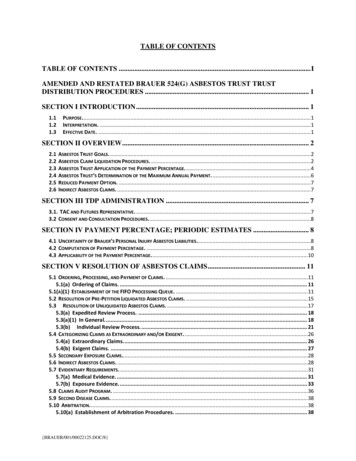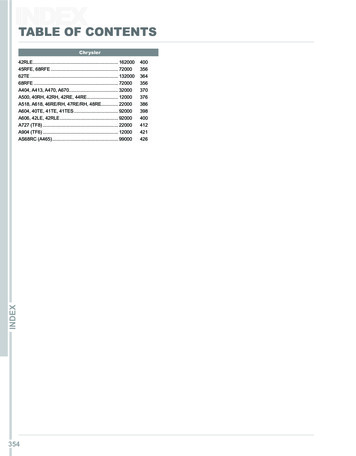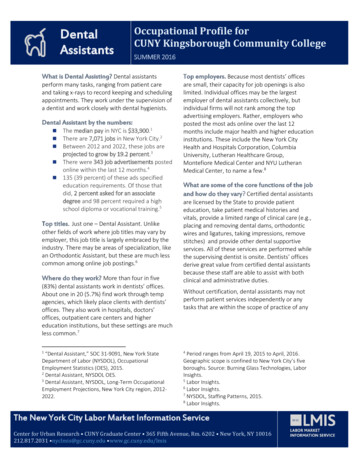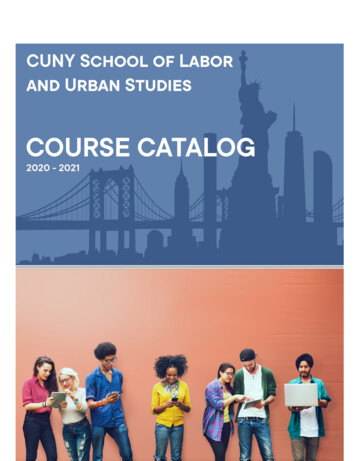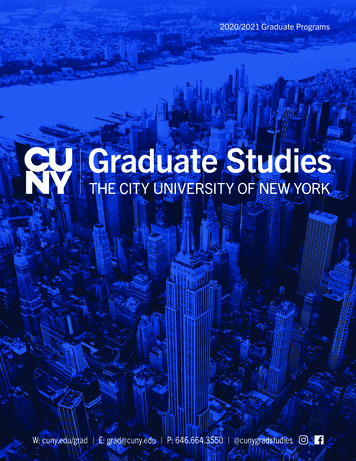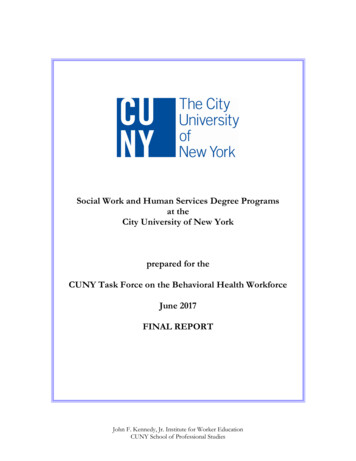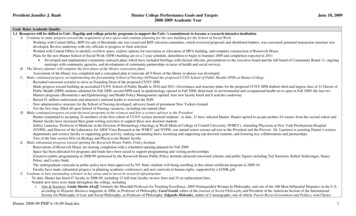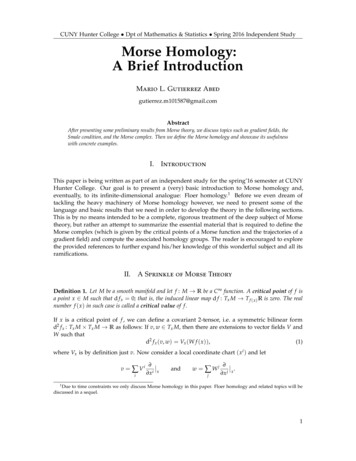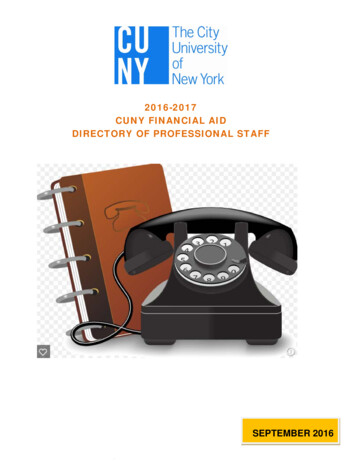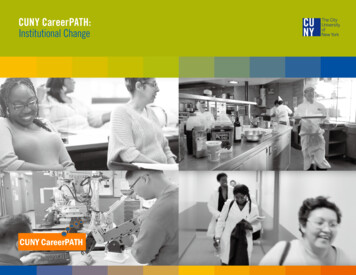
Transcription
Table of ContentsAbstract . 31.Purpose and Goals . 42.Rationale . 53.Need and Justification . 64.Students . 7A.Interest/Demand . 7B.Enrollment . 8C.Admissions Requirements. 9D.Dismissal, probation and graduation . 95.Curriculum . 116.Faculty . 177.Cost Assessment . 228.Evaluation . 249.Conclusion . 26APPENDICES . 29Appendix A: Community Agency Questionnaire . 30Appendix B: Social Work Students Interests in Graduate Education . 32Appendix C: Courses Descriptions . 37Appendix D: Five Year Financial Projection. 44Appendix E: Sample Evaluation of Student Learning Outcomes Instrument . 58Appendix F: Program Scheduling . 67Appendix G: Faculty Teaching Assignments . 73Appendix H: Faculty to be Hired . 76Appendix I: Evaluation Report Form . 78Appendix J: CSI Library Report for Social Work . 972
AbstractDue to the demonstrated demand and interest, we propose to develop and implement a Masterof Social Work (MSW) degree program at the College of Staten Island. By educating studentsfor advanced, urban social work practice, with a specialization in disabilities, CSI will preparestudents to meet the multiple demands of social work practice on Staten Island, and in theregion.The curriculum will follow that which is required for professional accreditation by the Council onSocial Work Education (CSWE) and for licensure in New York State of Licensed Master SocialWorkers and Licensed Clinical Social Workers. An MSW degree is required for licensure in NewYork and is the terminal practice degree for the profession. In addition, for Medicaid to pay forthe clinical services that people with developmental disabilities require, the provider must belicensed and hold no less than a Master’s degree.The establishment of a Master’s of Social Work is aligned with three of the six strategicdirections in CSI’s strategic plan. Strategic Direction (SD) 1 urges the college to develop a richerarray of undergraduate and graduate degree programs that meet students’ educational andprofessional aspirations. SD 3 encourages increased student engagement with the community.Strategic Direction 4 seeks to strengthen and increase our ability to serve a broad and diversecampus community. We have designed the proposed Master of Social Work with thesestrategic directions in mind.The MSW program will be housed in the proposed Department of Social Work. The Departmentof Sociology, Anthropology, and Social Work, which also houses the existing Bachelor ofScience in Social Work, has voted for social work to become a Department effective fall, 2014(the department proposal is under development). A cost analysis, included in this proposal,shows that the program will be self-sustaining beginning in year one.This proposal outlines aspects of the Master of Social Work degree program including purpose,explanation and evidence of need and demand, a description of the curriculum, the cost toimplement the program, and expected income that will be generated from the program.3
1. Purpose and GoalsThe purpose of the Master of Social Work (MSW) program is to educate students foradvanced, urban social work practice in the community, region, and worldwide, with anemphasis on meeting the needs of people with disabilities. Social work is a profession thatstrives to create a just and equitable world for the future of humanity. Guided by a code ofethics, social work is committed to ending oppression, embracing diversity, and ensuring thatindividuals, communities, and organizations function at an optimal level. CSI is located on theformer campus of the Willowbrook State School, an institution for people with developmentaldisabilities that was closed due to inhumane conditions and inadequate management. Given thehistory of Willowbrook State School, it is part of the mission of the MSW program at the Collegeof Staten Island to develop a rigorous academic program that educates professionals whorespond to the needs of former Willowbrook residents and clients, the larger disabilitiescommunities, and others who live on Staten Island and in the region.The establishment of a Master’s of Social Work is aligned with three of the six strategicdirections in CSI’s strategic plan. Strategic Direction (SD) 1 urges the college to develop a richerarray of undergraduate and graduate degree programs that meet students’ educational andprofessional aspirations. SD 3 encourages increased student engagement with the community.Strategic Direction 4 seeks to strengthen and increase our ability to serve a broad and diversecampus community. We have designed the proposed Master of Social Work with these strategicdirections in mind.The curriculum will follow that which is required for professional accreditation by theCouncil on Social Work Education (CSWE) and meet licensure requirements of New York Statefor Licensed Master Social Workers and Licensed Clinical Social Workers. An MSW degree isrequired for both of these licenses in New York and the MSW is the terminal practice degree forthe profession. In addition, for Medicaid to pay for the clinical services that people withdevelopmental disabilities require, the provider must be licensed and hold no less than aMaster’s degree.It is critical to the purpose and goals of the MSW program to center the voices of peoplewith disabilities. Therefore, the MSW program and curriculum has been developed inconsultation with people with disabilities and remains committed to the inclusion of people withdisabilities as we move forward. In addition to admitting students with disabilities, hiring facultyand staff with disabilities, and placing our second year students in internships with agenciesserving people with disabilities, we are developing a community advisory board that includespeople with disabilities. We are in the process of identifying potential advisory board memberswith plans for an initial meeting in September, 2013.The goals of the Master of Social Work program are as follows:1. Educate outstanding social work practitioners in an intellectually rigorous environment sothey can practice social work in urban settings and with diverse communities.2. Educate advanced social work practitioners prepared to work with and on behalf ofpeople in need, grounded in a social constructionist perspective, with a special emphasison former Willowbrook State School residents, people with disabilities, and organizationsserving people with disabilities.3. Provide professional opportunities for MSW students in a variety of sectors and settings.4. Engage in faculty research, scholarship, and service which will advance theory, policy,and practice in the profession of social work and in the field of social welfare moregenerally.5. Provide faculty expertise and leadership toward strengthening urban communities,particularly Staten Island and the region.4
2. RationaleStaten Island has nearly half a million residents and is part of one of the most importantand opportunity-filled cities of the world. Due to the island’s geography, Staten Islanders tend toseek the majority of needed services within the borough and rely heavily on local schools,hospitals, and social service settings in the community. Many of these agencies struggle withinadequate resources and increasing need; they find it extremely challenging to recruitprofessionally educated social workers and often make do with staff that are ill-equipped toserve their clients well.There are no public graduate social work programs on Staten Island, and the two MSWprograms existing in CUNY are geographically inaccessible to Staten Islanders, given bridgecosts and the failure of the City to extend the subway system to the Island. As CSI increases itsemphasis on professional accreditation, the baccalaureate program in social work is engaged inthe process of accreditation by the Council on Social Work Education (CSWE).This changeincreases the rigor of the program, supports the opportunity for advanced placement in graduateschool, and makes it possible for more of CSI’s social work students to pursue graduatedegrees in CSWE accredited MSW programs. An MSW is a clearly articulated goal of themajority of social work students at CSI. The College should have an MSW program where itsstrongest students can matriculate. A sufficient cadre of well-trained advanced social workpractitioners is also a demand of the community.As with all communities in a time of recession and high unemployment, social problemsabound, but like most urban areas, Staten Island also has an impressive array of strengths.What is most remarkable about Staten Island at this juncture is its unparalleled growth inpopulation: in the period from 2000 to 2010 the population increased by 5.6% as compared witha 2.1% increase in New York State. In terms of race and ethnicity, Staten Island boasts themost rapidly diversifying population among the five boroughs. Staten Island has an enormousinflux of new immigrants, with a wealth of primary languages.New York City has a large and diverse population of people with disabilities. The numberof people with disabilities is similar to the national average, with approximately 18% reporting adisability and 12% reporting a severe disability (Brault, 2012; DisabilityPlanningData.com, n.d.).Thirty-eight percent of people with disabilities in New York City live in households with a medianannual income under 15,000 (New York State Department of Health, 2007). On Staten Island,28% of people with disabilities speak a language other than English at home(DisabilityPlanningData.com).From 1947-1987, Staten Island was home to the Willowbrook State School, the largestfacility for people with developmental disabilities in the U.S. As a result of a 1974 class actionlawsuit about the inhumane conditions and overcrowding at the institution, the facility waspermanently closed in 1987. Many former residents of Willowbrook, now in their 40’s and older,remain on Staten Island. Approximately half of Volunteers of America's clients who live inIndividualized Residential Alternatives on Staten Island are former Willowbrook residents(Volunteers of America, 2012).The needs of long term residents and newcomers alike pose challenges for programs onStaten Island. Inadequate funding and insufficient education of social workers on the Islandstrain local social service networks. CSI proposes an MSW program to help address thesechallenges.5
3. Need and JustificationNo college or university offers an MSW program that can be taken in its entirety onStaten Island, nor is there a public MSW program on the island. The two MSW programs atCUNY are at Hunter College and Lehman College. Lehman College receives over 400applications and has the capacity to accept 100. Hunter receives approximately 1,700applications for the MSW program each year. According to their admissions office, they accept25% (approximately 425 students). Based on the application statistics provided in Hunter’sresponse to CSI’s Letter of Intent, 44% of applicants (approximately 750) are not qualified. Theremaining 525 people, from their pool of 950 qualified applicants who seek admission to a publicprogram, are not accommodated by Hunter. Hunter indicated they receive 1.5% of theirapplications from Staten Island. This means they receive approximately 30 applications eachyear from Staten Island and, based on their acceptance rate, they accept 5-6 Staten Islandstudents into their program. This meets neither the need nor the demand for MSWs on StatenIsland. The NYU program offered on Staten Island receives 25 to 30 applications from StatenIsland each year and they accept about 20. Per prior agreement with NYU, their MSW programwill no longer be located at CSI after the end of the 2012-2013 academic year. (The revenuegenerated to the College for rent of office space was not part of the revenue stream for thesocial work program. Therefore, the program does not incur any loss of income due to thedeparture of the NYU program.) It is anticipated that the CSI MSW program will receive at leastas many applications for our two year program as NYU currently receives, plus double thatnumber for our advanced standing program (we will have approximately 100 CSI BSSWstudents eligible for our advanced standing program by 2014). This should result in anacceptance rate that is similar to the national average of 63% for full time and 72% for parttime MSW students [CSWE, 2011].A survey conducted in the Fall, 2011, of community social work agencies (26questionnaires were distributed with a total of 20 responses) that currently serve as fieldplacements for CSI baccalaureate social work students found that all (100%) identified a needfor an MSW program on Staten Island. Most (85%) indicated that a concentration in disabilitieswould be beneficial for the community (see attached questionnaire in Appendix A). Disabilitiestied with geriatrics and substance abuse as the most common fields of practice respondentsidentified as needed on Staten Island; clinical practice was the most common practice methodrespondents identified as needed on Staten Island.In addition to local need, the Occupational Outlook Handbook, 2010-2011 indicated thatfor the nation,employment of social workers is expected to increase by 16 percent during the2008–18 decade, which is faster than the average for all occupations. Thegrowing elderly population and the aging baby boom generation will creategreater demand for health and social services, resulting in rapid job growthamong gerontological social workers. Employment of social workers in privatesocial service agencies also will increase. (n.p.)Social workers are not highly paid, at either the BSW or MSW level, and salaries do not tend tobe the primary draw for the profession. While the median salary for social workers ( 42,480[Occupational Outlook Handbook] to 55,000 [NASW, 2010a]) is lower than that for manyprofessions that require similar levels of education, it is still higher than the median incomewhen considering all occupations in the U.S. ( 33,840) (Occupational Outlook Handbook,2011). In determining potential salary, many factors must be considered: sector, setting,practice area, region, additional certifications, etc. Although we expect our MSW students to be6
marketable in any sector, setting, or practice area, the practice area for which we arespecifically preparing our MSW students has a median base pay that nationally ranges fromhigher than the median ( 55,300 for developmental disabilities) to just below the median( 54,100 for health) (NASW, 2010a). The median salary for social workers in New York is thethird highest in the nation.at 62,400 (NASWa). The median salary for MSW educated socialworkers is 15,000 to 22,000 more per year than for BSW social workers (NASW, 2010b).For all social workers, the middle 50 percent earned between 31,040 and 52,080.Median annual wages in the industries employing the largest numbers of child, family,and school social workers in May 2008 were:Elementary and secondary schools 53,860Local government 46,650State government 39,600Individual and family services 34,450Other residential care facilities 34,270Occupational Outlook Handbook, 2010-2011, n.p.The empirical research on expected trends for social workers does not separate theanticipated demand for BSW’s from MSW’s (NASW, 2010a; Occupational Outlook Handbook,2010). However, according to the Bureau of Labor Statistics (2012), most jobs in the sector inwhich many of our MSW students are likely to be employed—healthcare—require an MSW; thissector is expected to increase by 34% in the next 10 years. A 2006 study by the U.S.Department of Health and Human Services (DHHS) indicated that one of the most pressingrecruitment problems in New York public health departments is hiring enough social workers.Most supervisory and all clinical social work jobs require an MSW degree. Finally, the passageof federal legislation that provides loan repayment or forgiveness for licensed clinical socialworkers who agree to work in Health Professions Shortage Areas (HPSA) suggests thatgovernment incentives are needed to meet the demand for MSWs (U.S. DHHS, 2011). Thus,we conclude that an MSW will provide our graduates with a competitive advantage in findingsatisfying employment.4. StudentsA. Interest/DemandIn the Fall, 2011, students who were enrolled in the Bachelor of Arts in Social Work(BASW) program at the time and students entering the Bachelor of Science in Social Work(BSSW) program participated in a survey using self-administered questionnaires (Appendix B).Forty-three students (74%) responded. Most (70%) were from the junior class of students in thenew baccalaureate program. Ninety-five percent (95%) of students indicated they want to goforward with a Master’s degree in Social Work; two were unsure. When asked which college oruniversity they would most like to attend, 68% listed CSI as their first choice, and all but twostudents (95%) listed CSI in their top three choices of colleges they would like to attend. Eightysix percent reported they are “very likely” to apply to CSI if we have an MSW program, whil
No college or university offers an MSW program that can be taken in its entirety on Staten Island, nor is there a public MSW program on the island. The two MSW programs at CUNY are at Hunter College and Lehman College. Lehman College receives over 400 applications and has the ca
